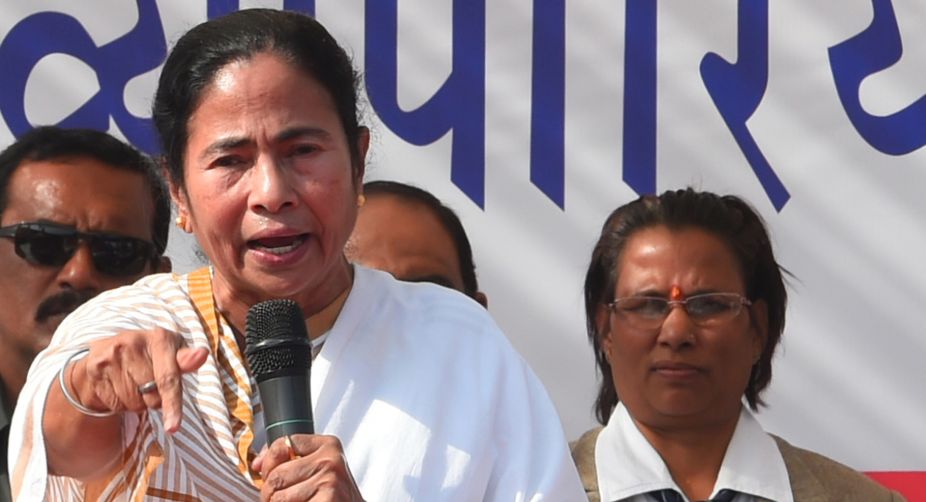Kejriwal govt running on an arbitrary, unconstitutional system: Sachdeva
Addressing a press conference, the Delhi BJP chief said, “The Arvind Kejriwal government operates in an arbitrary and unconstitutional manner.

What
is the game plan of West Bengal chief minister Mamata Banerjee? When she emerged
as the heroine after dethroning the CPI-M in 2011 after it had ruled the state
for 33 years, many thought she might not
come back for a second time. But she surprised all by winning a creditable
victory in 2016. She had been on the look out for an opportunity to play a
bigger role in national politics and had attempted to form pressure groups to
take on the Centre but had not succeeded. Her efforts to combine with Bihar
chief minister Nitish Kumar and Samajwadi party chief Mulayam Singh or Delhi
Chief Minister Arvind Kejriwal these past few years are proof enough.
Mamata
heads the seventh national party. Trinamool Congress is the third largest party
in the opposition following Congress and AIADMK. With the Left floundering and
the Congress influence in the state weak, TMC is expecting an increase in its
current tally of 34 MPs in the Lok Sabha. She hopes that the party’s increased
relevance nationally would also help her in the state. For her, 2019 is the
time to climb the ladder towards the top job. In fact, even before Narendra
Modi had announced the demonetisation move, Mamata had been planning another
meeting of ‘federal front leaders’ in Delhi.
She has now found an issue that would unite all
non-BJP leaders. Further West Bengal has been hit hard because of
demonetisation as a major part of the unorganized sector is facing the brunt.
There are already long lines outside banks and once people’s anger swells it
might become uncontrollable. So what better way than to join the people in
bashing the Modi government?
Advertisement
Mamata’s
opportunity to establish her national importance came when Prime Minister Modi
announced his surprise demonetisation of high value currency on November
8. While many welcomed the measure,
Mamata criticised it within one and a half hours even before the others could
digest what was happening. As surprise and shock enveloped the nation with
people running hither and thither for exchange of old notes for new, Mamata
plunged deep into her confrontational politics, which she knows much better
than others.
Mamata
promptly telephoned Congress leader Rahul Gandhi, SP chief Mulayam Singh, JD
(U) leader Sharad Yadav and Delhi chief minister Arvind Kejriwal and even her
sworn enemy, the CPI-M to
join
hands with her. She was successful to a
large extent when even NDA partners like the Shiv Sena responded to her call.
Parties like the AAP and Shiv Sena would rather respond to her call than to
that of the Congress leadership. This is obviously an important revision from
her earlier position of remaining a backroom operator.
The
result was an impressive show this week in Parliament in front of the Gandhi
statue when 200 MPs from these ten parties demonstrated against demonetisation.
The combined opposition attack has stunned the Modi government as it was going
ahead without any protest. While the opposition did not project her as its
leader, it was clear that Mamata played a key role. She also met President
Pranab Mukherjee to lay the ground for a meeting between him and all opposition
parties scheduled for November 28, the day when country-wide protests are to be
held.
It
is well known that before the 2014 Lok Sabha polls, many regional satraps
including Mamata, Jayalalitha and Nitish Kumar had hopes of becoming prime
minister in case a non-BJP coalition government was formed. To their
disappointment the Modi-led BJP secured a handsome majority and led the
government. Two and a half years later, Mamata has still not given up her
ambition.
She
has seized every opportunity, be it at the height of farmers’ anger over the
seizure of their land in Singur and Nandigram before the 2011 polls or the
present demonetisation in the prelude to the 2019 polls. The next step in
Mamata’s plan is to go round the country taking the fight to the streets. She
is planning to address rallies in
Lucknow, Patna and Varanasi and then move on to other states in the coming
days. As part of her efforts she is also learning Hindi.
Mamata
has chalked out her plan. The first is to unite the non-BJP opposition. This is
what she will find difficult to sustain. The second, which is more difficult,
is to perusade them to accept her as the opposition face in the 2019 polls. A
declining Congress has given her space to emerge as the leader on the national
scene. Now Mamata has enough time on her hands to prepare for this huge task.
Chances of her success depend upon how quickly the Modi government is able to
resolve the present cash crisis and how long the opposition parties back her.
It is too early to predict the future as the next Lok Sabha polls are two and a
half years away. But no body can fault Mamata for trying to become the
opposition face.
–By
Kalyani Shankar
Advertisement